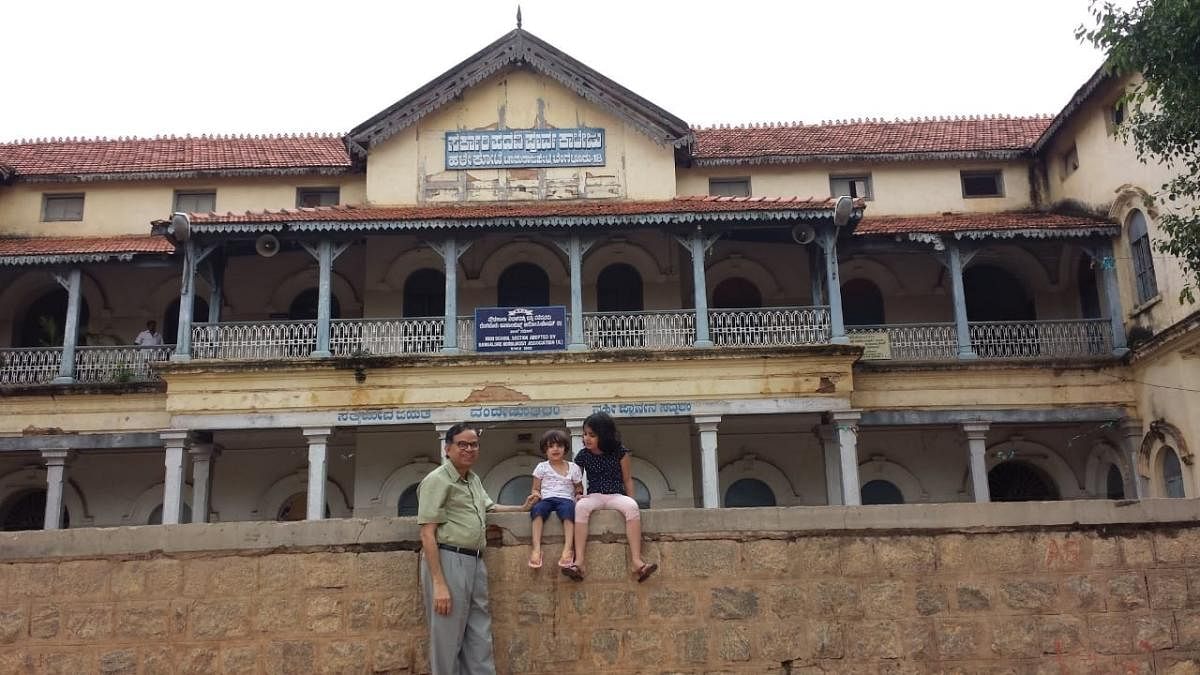
When I first saw Fort High School in Bengaluru, I was impressed by its stately building, wide verandas and large playground. Already over 40 years old, the school had acquired dignity and reputation.
It was located at a junction of four broad roads, decorated with a tall ornamental tower with five lamps. Its immediate neighbours were Tipu Sultan’s palace, a Venkataramana temple, a Sanskrit college and a medical college. Nearby were the City Market and remnants of an old fort. I felt very proud to join such a distinguished school.
It was a popular school for boys, with over 1,200 students in three classes. First year students were in sections A to G, each with about sixty students. I joined a group of young, energetic and enthusiastic boys in the F section. The next three years were the best in my academic career.
I studied in Fort High School during an exciting period, 1957 to ‘60. Free India was only ten years old. Kannada-speaking areas from adjoining states were added to the old Mysore state in November 1956. Vidhana Soudha had just been completed. At the national level, new metric systems for coinage, distance, weight and quantity measurement were introduced in 1957. People were getting used to naya paisa, kilogram, kilometre and litre.
There was an expectation of great change in the country. At the international level, space exploration had caught the imagination of people. Russia had sent the first satellite, Sputnik, and followed it up by sending a dog into space. The name of the dog, Laika, became well known.
Space exploration excited everyone so much that my Sanskrit teacher, Renukaradhya, devoted a whole hour to explain how the Soviet rocket had escaped gravity to enter outer space and put the satellite in orbit.
Barring some students who used bicycles, most of us walked to school. Jeans, T-shirts, shoulder bags and plastic water bottles had not yet appeared. Most of us wore shirts and white cotton pyjamas to school. We would have our lunch box in hand and carry our books and notebooks in cotton sling bags. We looked quite different from the smart school boys of today.
Our teachers were generally good humoured. When our new science teacher, Hanumayya, arrived, the class was noisy. He wrote CO +2FE =? on the blackboard and asked us to answer. None of us could. We all broke into laughter when he wrote COFFEE against the equation.
Our biology teacher, Srinivasa Murthy, would also talk about physiology, arousing the curiosity of adolescents. He would suddenly stop, saying that if we wanted to know more, we should go to the college next door. He was referring to Bangalore Medical College. We would have to study hard to get into that college!
I was in an English-medium section. It had students whose second language was Sanskrit, Tamil, Telugu, Urdu, Arabic and Persian. Some had names difficult to pronounce for teachers who did not know those languages. They had to read out the names while taking attendance. I remember my mathematics teacher, Narayana Iyengar, calling Ehtesham-ul-hai by the name of Mr X! The school had a wing of Boy Scouts. Our history teacher, Syed Abdul Gafur, was in charge. In addition to learning to march smartly, we learnt the motto, ‘Be prepared,’ and sang scout songs like ‘There is never any trouble if you S-M-I-L-E’.
Our Kannada teacher, K Pattabhiramayya, who had published his poems, was in charge of cultural activities. He used to send us to inter-school competitions outside Bengaluru. He used to travel with us to ensure our safety and comfort.
Our headmaster, Krishnaswamy, used to invite good speakers to address us. For Gandhi Jayanti, a humorist spoke on Gandhi and humour. Saying Gandhi loved a good joke, he regaled us with many jokes not limited to Gandhi. I remember him telling us a joke about an election rally. The campaigner, an opposition leader, listed allegations of corruption against the ruling party. Finally, he said, ‘They have done this for all these years. This time, please give us a chance.’ Obviously, politicians were no different even 60 years ago!
The playground is still the venue for the annual Ramanavami concerts. The school building was old even in my time. It had lost its original red colour and was painted in cream.
However, it was still a strong and imposing structure. The succeeding decades must have taken their toll. A few years ago, my grandchildren wanted to see my old school. It had completed more than a hundred years. While the children were thrilled by the heritage look of the school, I observed that the building needed repairs.
Luckily, its condition attracted the attention of citizens interested in conserving the heritage of Bangalore. I am happy INTACH has restored the building to its old glory. May my old school continue to educate our youth and remind them of our heritage.